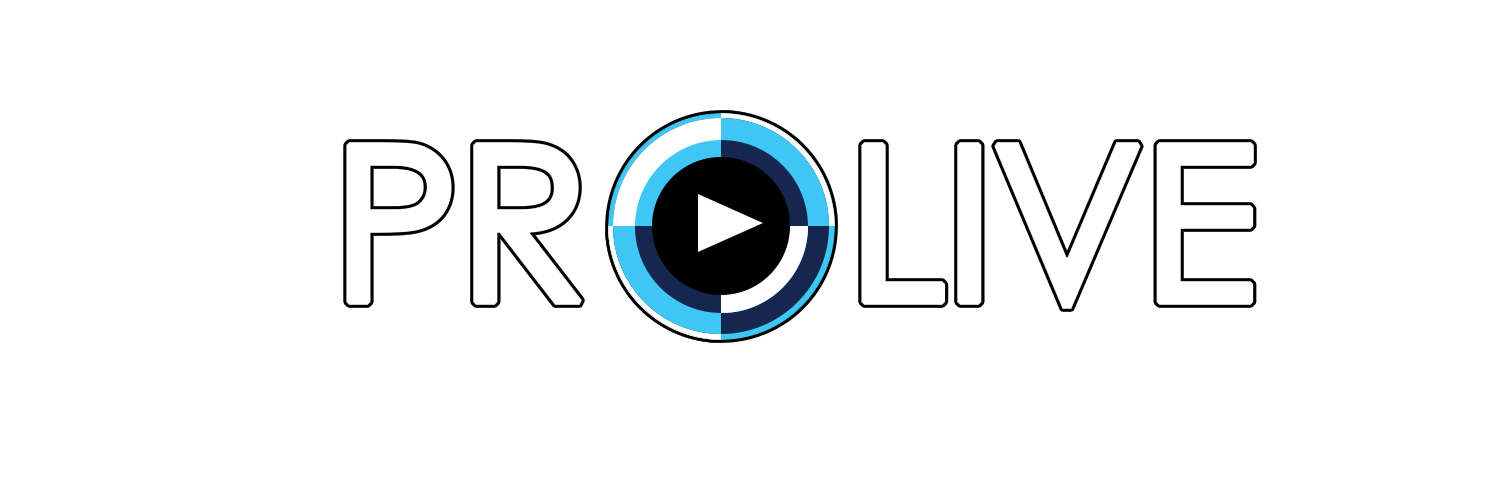History of Live Streaming
Getting on top of the marketing ladder is not a walk in the park.
Everybody knows that.
If it was easy, we won’t be spending hours and hours brainstorming, researching, and improving marketing strategies.
But here we are, gnawing at our brains and exhausting resources so we can reach more of our target audience.
Eventually, we stumbled upon live videos.
Of course it started way before Youtube and social media.
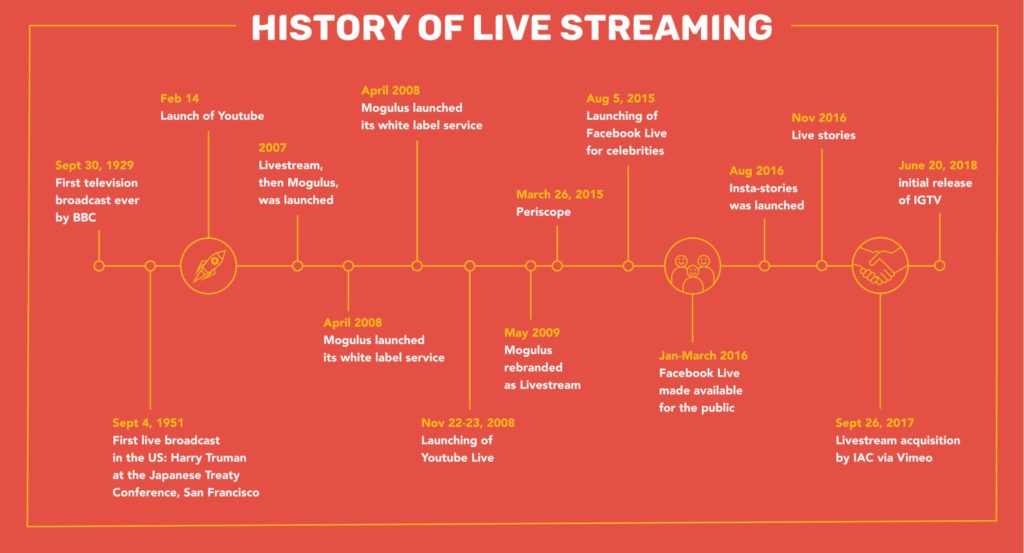
When the first ever live broadcast was made in 1929, it opened a whole new world for television.
It became heavily popular until late 1950s and was still used in the ‘70s. After that, production companies slowly adopted the use of videotapes. Live television was in a decline as prerecorded videos presented fewer risks.
However, in 2005, everything changed.
It was the year Youtube was launched.
From then on, there’s a massive shift in the way internet users consume information. Year after year, the hours we spend watching stuff online only increase.
It wasn’t too long after someone realised that live videos actually fit perfectly in the world the internet is slowly building.
It’s the age of information.
What’s better than reviving raw, unscripted, real-time content?
So Livestream was born in 2007. More than 10 years later, we have countless of live streaming platforms that cater to the different needs of content makers and audience alike.
Table of Contents
- Why Live Streaming is a Force to Reckon With
- Live Streaming Basics You Ought to Know About
- Different Platforms to Go Live
- Focus on Facebook Live
- Studying Consumer Behavior
- Best Live Videos Ever Made
- Live Streaming Tips that Work
Why Live Streaming is a Force to Reckon With
Okay, I might be overly dramatic with how I decided to call this part but it’s true, isn’t it? It’s a force to reckon with.
If you’ve been live streaming for quite some time now, you know what I’m talking about.
But if you don’t, let me show you the numbers.
This might be quite outdated for your taste but by June 30, 2018, 4,208,571,287 humans have already gone online. Considering the estimated world population at that time, that’s more than half of us here on earth.
But that’s not all.
By 2030, it is projected to reach 90%.
Now, how do these internet users utilise the internet?
Most of these people, 3.196 billion of them in fact, are active social media users.
So what do they do on social media? Lots of things, of course.
But let’s talk about the type of content that engages them the most.
You guessed it right, video posts.
To give you an idea, think of the number 1200%. That’s how much video posts are shared compared to photos and text.

If you’re not convinced, let’s take a look at the Cisco Visual Networking Index: Forecast and Trends, 2017-2022. It gives us a lot of useful statistics and projections but let us focus on one area: the projection on video traffic.
According to the index, internet video traffic is expected to grow fourfold by 2022. What’s more impressive is what it says about live video. By observing its current growth, it will likely grow 15-foldby the same year.
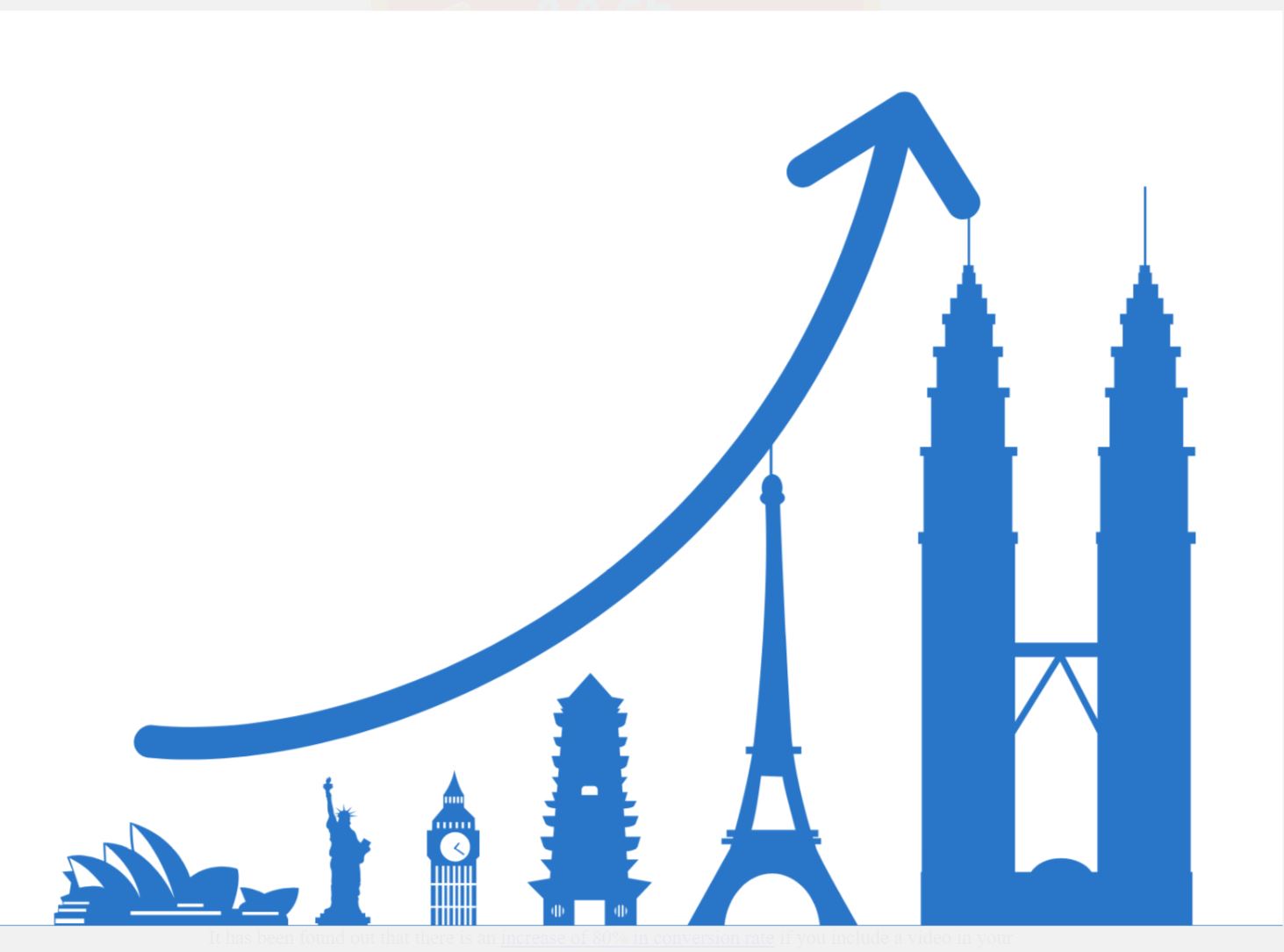
But what does it mean for businesses and organizations that actually use videos?
It has been found out that there is an increase of 80% in conversion rate if you include a video in your page or even email. In fact, 57% of consumers expressed that they are more likely to purchase online after watching a video about the product.
For someone who wants to be heard, that’s one of the most important things to look into.
Another is SERP ranking. People depend so much on search engines such as Google. Including videos is a great way to optimize your page. That’s why 87% of marketers worldwide have decided to incorporate them into their marketing strategies.
Now, looking at this data, it’s silly not to jump into the bandwagon as soon as you’ve got the chance.
But how we wish it’s that simple.
How we wish we could just do this thing, have a camera in front of us, start live streaming by putting our product out there or getting our message across, and people will come flocking to it. Like magic.
But no. It can be tedious. This is one of the reasons this article was written: to make things a little bit easier for you.
Live Streaming Basics You Ought to Know
Live streaming, just like everything else, follows a process. Even if you are planning to hire professionals to take care of it for you, knowing some of the details, if not all, can come in handy.
To not bore you with the technical details and terms we are going to summarise it into 4 steps.
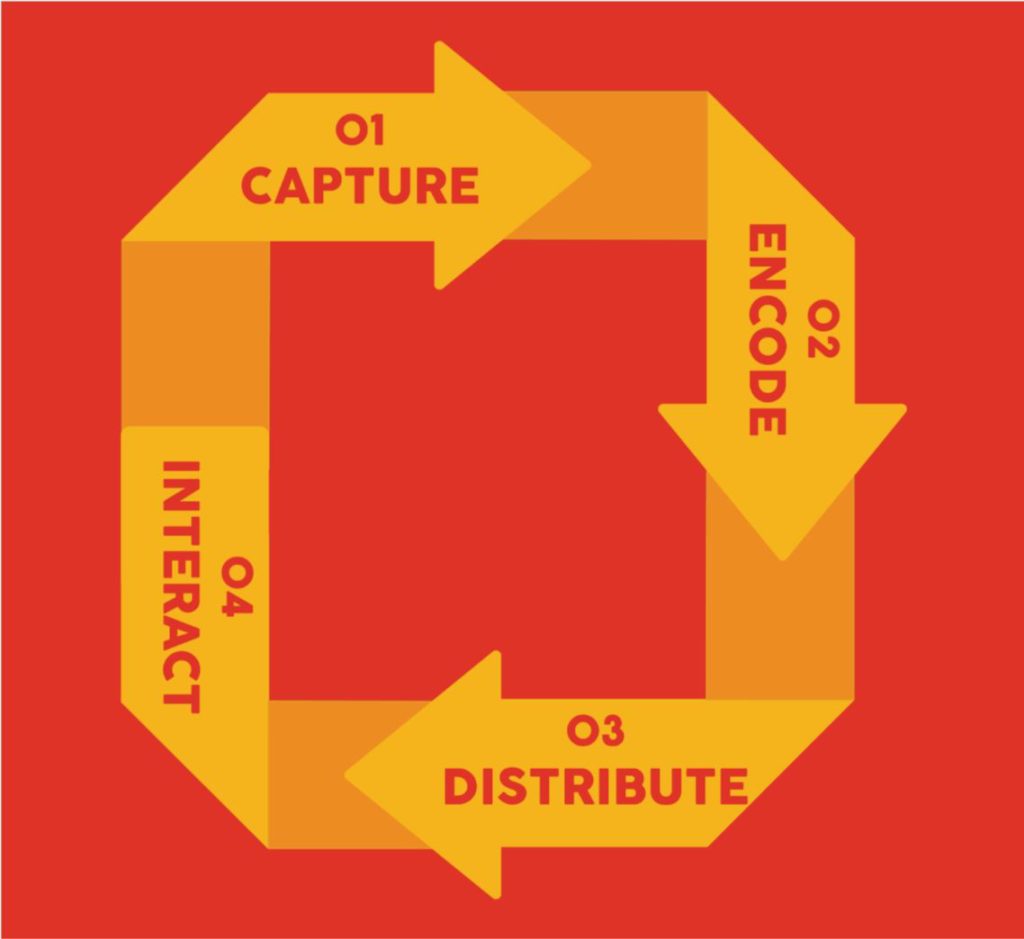
Capturing
In the actual live streaming, it starts with capturing your content. There are, however, things—such as planning and preparations—that must be done before that.
So in capturing, you will need your production equipment: cameras, microphones, projectors, lighting equipment, etc. This step is focused on filming your content.
It’s very important to note that there are things that can go wrong at this point—issues such as device malfunctioning, power interruption, and so many others can always happen—and they can happen during the other stages.
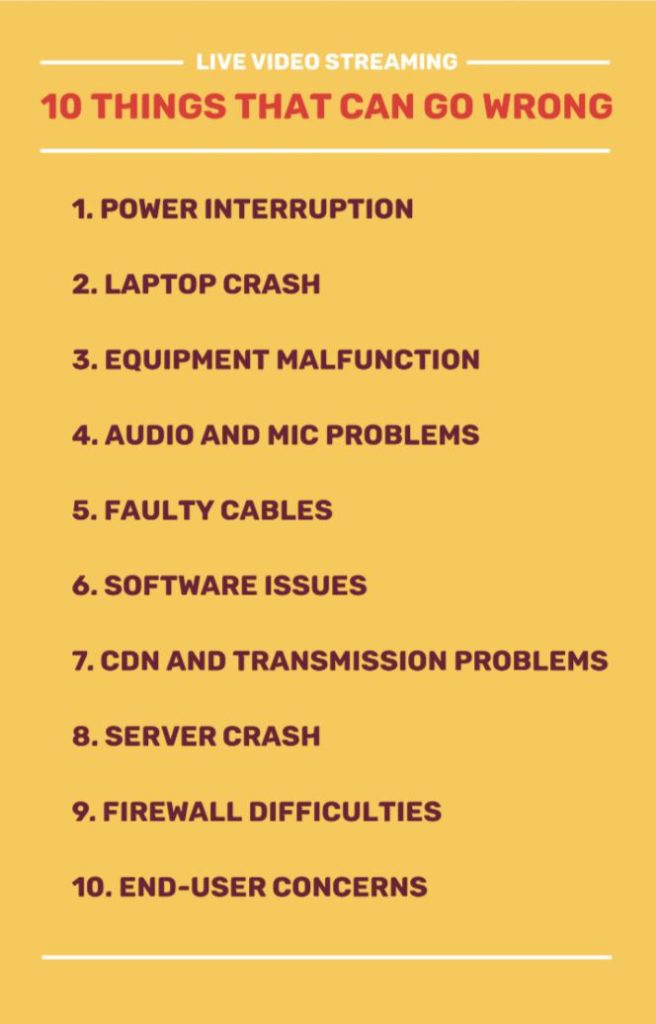
Encoding
The captured content will then be sent for encoding.
Without it, it’s impossible for your video to be played using different players and devices. In a nutshell, what it does is it turns your input into a final video format that your audience can view.
You notice that videos have different formats, or more precisely known as “containers”. We have MP4, AVI, WMV etc.

Let’s say for example you downloaded a video and there’s a prompt that says it can’t be played because it’s not compatible with your player. What a bummer, right?
The encoding part of live streaming prevents that from happening. You’d want as many people to view your content. That means, you’d want your video to meet the requirements of the most common containers.
Distribution
This is the part where your audience finally gets to see your live content on different platforms. They click on a link and gets directed to your site or live streaming platform. The process seems simple enough but it does involve a lot more.
For instance, there’s what we call Content Delivery Network or CDN that works hand in hand with your streaming server. Ideally, all connection requests from the users will be dealt with efficiently in this stage.
Interaction
The last stage is one of the things that make live streaming an effective marketing strategy. It engages the audience. It provides an avenue for them to leave comments, participate in polls, etc.
If you are going to hire a live streaming agency, it is possible for you to request more features than that. You can include more complicated functions such as allowing your participants to sign up for registration while watching the live video.
White Label Live Streaming
One of the things that you’re going to encounter a lot in live streaming is the term “white label”.
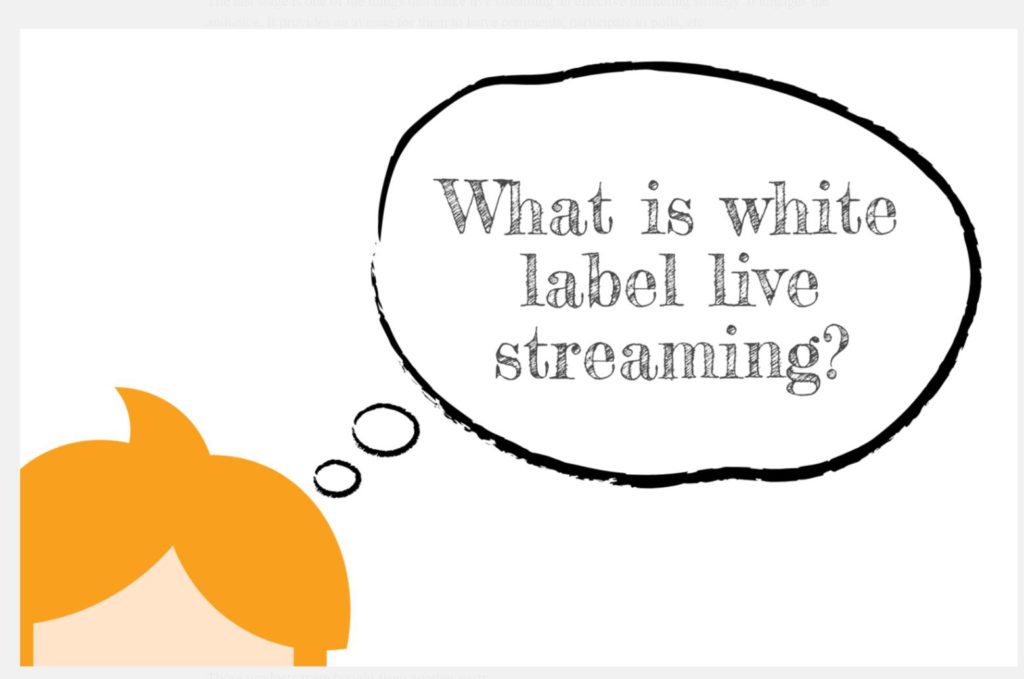
A white label product refers to one that is manufactured by a company but is distributed by another as their own.
Do you notice those items you buy from a supermarket and the brand name suggests that the supermarket itself produced those products?
Plot twist: they didn’t manufacture them.
Those products were bought from another party.
Now why does white label branding work in live streaming?
There are so many things involved in producing a high quality live video. You’d need the best software and equipment.
With marketing or brand awareness being only one of the many areas of your business or organization, you naturally can’t focus all of your resources on it. Investing on your own equipment to do a live video might not be the wisest decision.
That’s where live streaming service providers come in.
The best ones usually offer white label live streaming services because that means there’s only one brand that’s going to shine: yours.
Different Live Streaming Platforms and Service Providers

Youtube Live
Being the platform that uploads up to 300 hours of video per minute, Youtube deserves to be mentioned first.
Youtube Live was launched in 2008 and it’s undoubtedly one of the easiest ways to live stream. All you have to do is create a channel and stream straight from Chrome browser. You don’t need to worry about encoding because it’s Youtube, it’s compatible in almost all devices.
There are a number of reasons why it is loved by bloggers. For one, it’s popular. Second, it opens a great opportunity for revenue through ads.
Instagram Live
Instagram is one of the top social media outlets and as such, it’s a great place to find thousands, millions of audience. Designed for all users all over the world, Instagram Story is pretty much very easy to do as well. Going live just takes a few clicks. The catch is your live video will disappear after 24 hours unless you save it in your Highlights.
Periscope Producer
If you want to produce higher quality live videos, this is what you want to use. Here you will be using streaming software and video encoders. To make the most out of it, you’d also want to invest on a professional camera. Your audience can also leave comments or “hearts”.
Twitch
Twitch is a live streaming platform made especially for gamers. It has social features such as comments and whatnot but what makes it unique is it holds competition for gamers worldwide and allows game purchasing. With its 15 million active users, it’s no wonder why broadcasters love it.
BeLive
You have three options if you choose to broadcast via BeLive. You can go solo, have a live interview, or feature multiple guests. It boasts of bringing your Facebook audience to your page while you are broadcasting.
Now why would you choose this and not have Facebook Live itself?
There are so many things you can do with BeLive. Of course there’s the social aspect of it where you can see comments and respond to them. You can also make use of its custom logo and others. This is actually great for boosting brand awareness.
Another amazing thing about this platform is can tell you what matters to your audience while they’re watching your video through their Agenda and Crawler. Added to that, you can also show your presentations, photos, etc.
Is it free? To a point. You can use the platform twice per week for 20 minutes, free of charge. If you want to enjoy its features, there are plans you can avail and they start at $12/month.
Prolive
Prolive is one of the live streaming agencies in Singapore. The services include ensuring you are able to produce a live video that reaches your audience wherever they are. It streams to multiple channels and make use of reliable software and equipment. It can support solo or group interviews, conferences, events, and other types of live broadcasting.
If you are looking for professionals who can help you understand the technical aspects of live video streaming, they’re definitely the ones to contact.
Zoom
If you want something more flexible in terms of the size of your live event, Zoom is a great choice. It can support a meeting of two people, conferences, webinars, etc. What you would be excited about though is the other functions it includes.
It allows user registration, polling, app integrations, split-screen feature, Q&A, and so many others. Going live for 40 minutes and having 100 viewers/participants is free. Premium subscription can be purchased as $14.99/month.
LiveStream, DaCast, and IBM Cloud Video
These three is hailed by most reviewers as the top 3 live streaming platforms. To give you a quick look on how they differ, we have here a comparison table.

Source: https://www.dacast.com/blog/streaming-with-livestream-vs-ustream-in-comparison-with-dacast/
As you can see here, you have different choices according to the price and features. All three offer a free trial period but it’s noted that only Livestream doesn’t allow all features to be enjoyed by first time subscribers.
Facebook Live as your focus
As an avid internet users, we all know what the top websites are and Facebook is definitely one of them.
But do you know it’s the third most visited? Just behind Youtube and Google. That makes it the most famous social media outlet.
It doesn’t take a lot to figure out why it is very popular.
It connects people all over the world. That in itself is truly remarkable. Google closed the gap between us and the information we need; Facebook made this big world fit right into our hands. Almost.
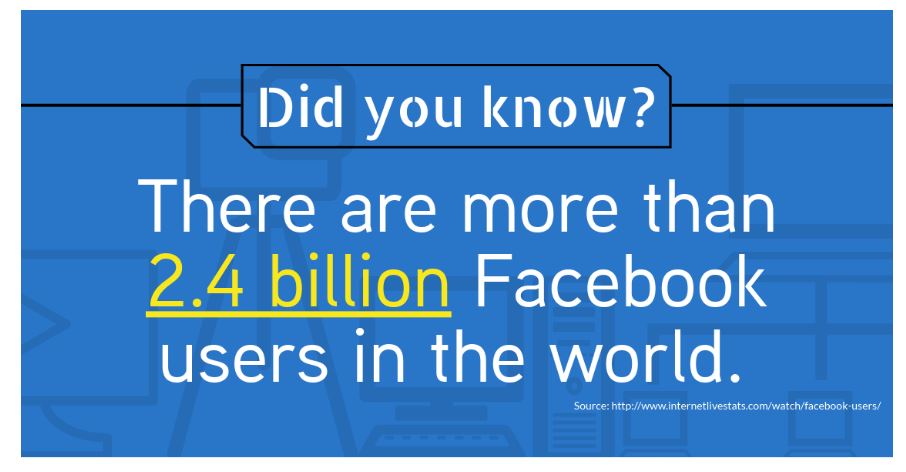
With just a few clicks, you’re privy to other people’s lives. Sharing ideas, political opinions, even what you ate this morning only takes literally seconds.
Furthermore, 78% of its active users are already watching live videos, making up the 100 million hours of videos that have already been watched on the site.
If this isn’t one of the greatest tools the marketing world has ever seen, I don’t know what is.
That’s why when you live stream, focusing on your Facebook audience is an imperative.
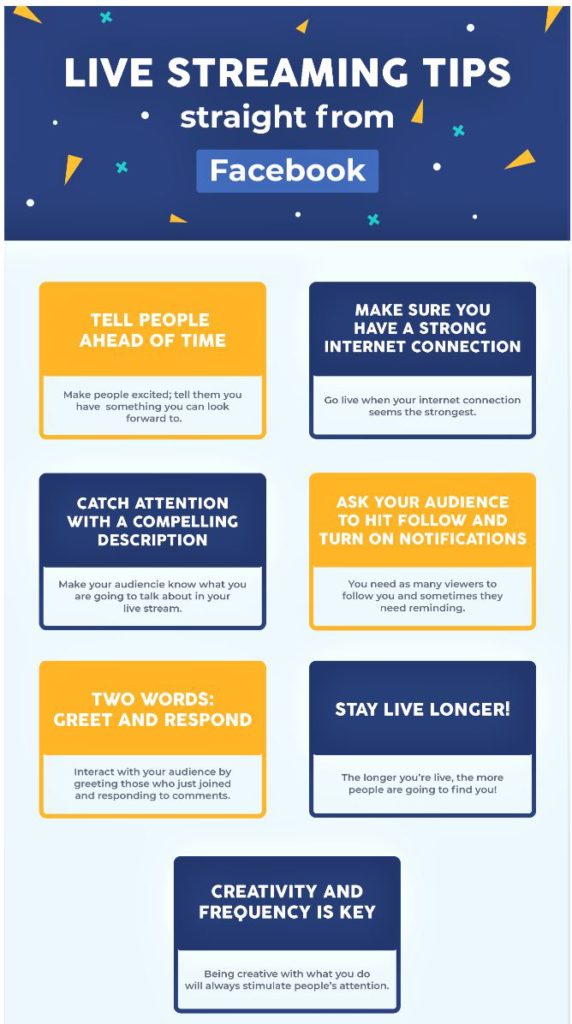
Studying Consumer Behaviour
Studying consumer behaviour is one of the early, if not the first, steps in brand awareness campaigns. It points you toward the best content ideas and approaches.
So how can you know what your audience really want?
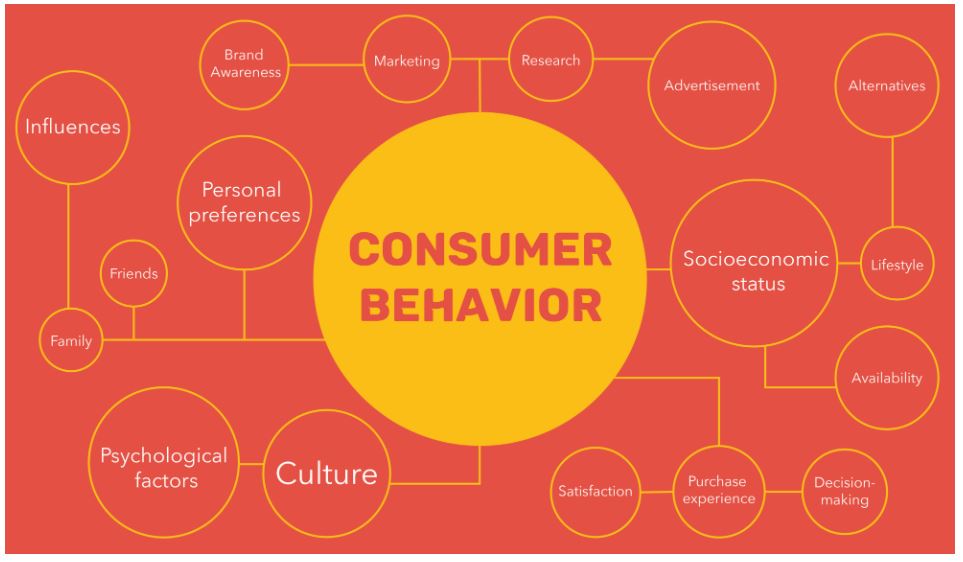
Well there are a lot of things that you can look into, aspects revolving around consumer behaviour. In fact, there are so many of them that it can sometimes be overwhelming, especially to startup businesses and organizations.
For example, you need to know how they think and feel in order to figure out the reasoning behind their unique selection processes. Why do they prefer this brand over that brand?
That includes not only their personal preferences but also psychological factors and social influences.
There’s also the reasoning behind their unique selection processes, wherein you need to look into their motivations.
Why do they purchase a particular brand over others? How do they arrive at such decision?
For someone who wants their company or organization to be known, you have to let yourself be plagued with these questions in order to have the best approach.
However, we are not going to delve into them. Not just yet anyway.
What we are going to talk about here is how you can get to know your live video audience using an extremely easy step.
Analytics: The easy way to analyse consumer behaviour
Although surveys and interviews are still helpful tools in finding out consumer preferences, analytics has basically taken over. We’re talking automated analysis in how your audience interact with your content and more.
Livestream Analytics is the best tool for your live video as it gives you data on so many areas. For example, you’ll know exactly the percentage of your audience who use mobile devices while viewing your content. You will also know where they are, their preferences, what engaged them the most, etc.
Best Live Videos Ever Made
There’s no fixed guide in how people should do live videos because there are different types of audiences, objectives, and so many others that comprise a finished product.
However, we do have some examples of great live videos you can emulate or pick up strong points from for you to improve.
Series-type live streaming
Martha Stewart – Call to action
One of the reasons you’re going live is you want to elicit an immediate response from your audience.
Ultimately you want to influence their behaviour. May it be following you, turning on the notifications for your posts, buying your product, visiting your page, etc. All of those are actions you want them to take.
This is why you sprinkle calls to action all over your content. Only you don’t really sprinkle them carelessly, you do it with finesse because people can see through manipulative schemes and they don’t like them so much.
In her live videos, Martha Stewart does it beautifully. If you’re a fan of Martha, then you’d know she does a lot of things in her videos but one of the favourites is her recipe tutorial. Here you get to learn not only about recipes but also useful hacks in the kitchen.
From time to time you will get a glimpse of her products, the ones she uses while telling it is better to slice almonds using a serrated knife. She talks about the products, what she loves about them—what you’ll love about them—, where you can find and purchase it, etc.
This call to action is so effective because it comes naturally. She doesn’t shove it down people’s throats. Another remarkable tactic I discovered is John Maclean’s.
According to his bio, he is an “aesthetic and interior consultant, an internationally published celebrity makeup artist and beauty expert”. He doesn’t do live videos yet.
Aside from the regal way he speaks and rich vocabulary, which is definitely a breath of fresh air in the makeup scene, there’s something remarkable about how he approaches subscription. He doesn’t tell people to subscribe. At the end of his videos, you see the words “Subscription is Optional”.

You don’t see this in a lot of videos where content makers almost beg their viewers to subscribe, which isn’t the wrong way of doing things. But if you want to be different, maybe incorporate some of John Maclean’s divine styles to your live streams.
Jason Carr – building up anticipation and curiosity
One of the tips given by Facebook is tell your viewers you’re going live soon. This is because you want to build up anticipation. But how can you get the same effect if you’re already live?
A great example is how Jason Carr takes his viewers to a trip without telling them where he’s going.
So he got into his car, gave the audience an idea how he got to this point, engaged them by having a Q&A. And finally he arrived to his destination which was, much to everyone’s surprise, his new station.
Tastemade, Buzzfeed, and Trey Ratcliff – Creativity and resourcefulness
One thing that you’ve got to love about the internet is how it presents countless avenues for creativity.
Take a look at this live Tiny Kitchen video from Tastemade, for example. It’s literally just an adult cooking food in a small kitchen. But people love it. Thousands tune in to their latest videos and more look them up on Google.
The comments section also provides a great way to get personal with your viewers. They ask a question, you answer them. What makes it better is you can do the same. You ask what your audience like and they respond right away.
This gives you a lot of content ideas.
Buzzfeed did exactly this. They had their “Dance Craze Battle: Live” where online viewers can vote and share ideas of what the staff should do. Simple yet creative
And lastly, the internet creates communities all over the world.
In his live video, Trey Ratcliff, a professional photographer, asked his internet friends to submit photos he can critique. Just in that premise, you’d know why a lot of people would love that content. It’s fun and very informative.
Tough Mudder – sense of community
Business and large companies are not the only ones that benefit from live videos. Organizations all over the world also make use of them to spread their message and cause.
One of the best examples is how Tough Mudder uses the platform to gain more awareness for its events.
If you watch their live videos, you will spot effective techniques on how they engage not only the audience present but also those who can’t make it to the event.
https://www.youtube.com/watch?v=kCVIqjE72s0
We’re talking about casual conversations with participants, subscription info here and there, questions, exposition of different parts of the program, and so many more.
Why do these things work?
Because it somehow brings the whole event right into their audience’s devices. It gives them the whole picture of what to expect, what it is all about.
Conclusion
Despite its popularity, there are still a lot of companies and organizations that haven’t incorporated live videos to their brand awareness campaign yet.
If you are one of them, you might really want to look more into it.
Remember that strategies in boosting your brand always change.
Live streaming is among so many and there’s always the chance that it’s going to be obsolete in the future.
But for now? It’s something you can’t miss out on.
